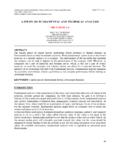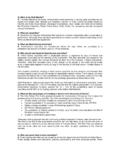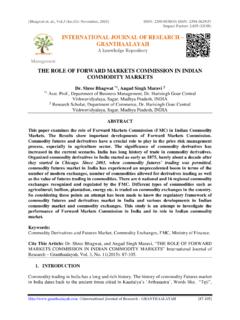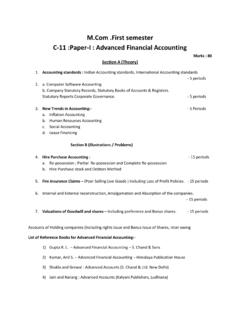Transcription of Non Performing Assets of Indian Banking System …
1 IOSR Journal of Economics and Finance (IOSR-JEF) e-ISSN: 2321-5933, p-ISSN: 7, Issue 6 Ver. III (Nov. - Dec. 2016), PP 21-26 DOI: 21 | Page Non Performing Assets of Indian Banking System and its Impact on Economy Pro. Rathore1, Malpani2, Sunita Sharma3 1 AMITY University Rajsthan ( Banking & Bus. Eco) College Rajsamand 3 Research Scholar AMITY Uniersty Jaipur I. Introduction of NPA Non Performing Assets Assets which generate income are called Performing Assets and but those do not generate income are called non- Performing Assets .
2 A debt obligation where the borrower has not paid any previously agreed upon interest and principal repayments to the designated lender for an extended period of time. The nonperforming asset is therefore not yielding any income to the lender in the form of principal and interest example, a mortgage in default would be considered non- Performing . After a prolonged period of non-payment, the lender will force the borrower to liquidate any Assets that were pledged as part of the debt agreement. If no Assets were pledged, the lenders might write-off the asset as a bad debt and then sell it at a discount to a collections asset becomes non- Performing when it ceases to generate income for the bank.
3 A non- Performing asset (NPA) is defined generally as a credit facility in respect of which interest and / or installment of principal has remained past due for two quarters or more. An amount due under any credit facility is treated as past due when it has not been paid within 30 days from the due date. It was, however, decided to dispense with past due .Worried over rising bad loans, a Parliamentary Panel has suo motu decided to examine the non- Performing Assets of the public sector banks that touched Rs lakh crore at the end of December 2015.
4 The combined net loss of 20 public sector banks (PSB) stood at Rs 16, crore for the fourth quarter ended March 2016 as bad loans situation worsened. PSBs registered net profit of Rs 4, crore in the corresponding quarter NPA concept which effect from 31 March 2001. Accordingly, as from that date, a NPA shall be an advance where Interest and/or installment of principal remain overdue for more than 180 days in respect of a term-loan. The account remains out of order for more than 180 days, in respect of overdraft / cash credit (OD / CC).
5 The bill remains overdue for more than 180 days in the case of bill purchased and discounted. Interest and / or installment of principal remains overdue for two harvest seasons, but for a period not exceeding two half years in the case of an advance granted for agricultural purpose. Any amount to be received remains overdue for more than 180 days in respect of other accounts. Objectives of the Study To study the status of Non Performing Assets of Indian Scheduled Commercial Banks in India To study the impact of NPAs on Banks.
6 To know the recovery of NPAS through various channels. To make appropriate suggestions to avoid future NPAs and to manage existing NPAs in Banks. II. Limitation of the Study The important limitations are as follows; The study of non- Performing Assets limited to the Indian Bank and till the end of the year 2015 The basis for identifying non- Performing Assets is taken from the Reserve Bank of India Publications. NPAs are changing with the time. The study is done in the present environment without foreseeing future developments. Scope of the Study The study has the following scope: The study could suggest measures for the banks to avoid future NPAs & to reduce existing NPAs.
7 The study may help the government in creating & implementing new strategies to control NPAs. The study will help to select appropriate techniques suited to manage the NPAs and develop a time bound action plan to check the growth of NPAs. Non Performing Assets of Indian Banking System and its Impact on Economy DOI: 22 | Page III. Review of literature Kaur K. and Singh B. (2011) in their study on Non- Performing Assets of public and private sector banks (a comparative study) studied that NPAs are considered as an important parameter to judge the performance and financial health of banks.
8 The level of NPAs is one of the drivers of financial stability and growth of the Banking sector. Chatterjee C., Mukherjee J. and Das (2012) in their study on Management of non- Performing Assets - a current scenario has concluded that banks should find out the original reasons/purposes of the loan required by the borrower. Proper identification of the guarantor should be checked by the bank including scrutiny of his/her (2012) in her study on Study on performance of NPAs of Indian commercial banks find out that corporate borrowers even after defaulting continuously never had the fear of bank taking action to recover their dues.
9 This is because there was no legal framework to safeguard the real interest of banks Why Assets become NPA? A several factors is responsible forever increasing size of NPAs in PSBs. The Indian Banking industry has one of the highest percents of NPAs compared to international levels. A few prominent reasons for Assets becoming NPAs are as under : Lack of proper monitoring and follow-up measures. Lack of sincere corporate culture. Inadequate legal provisions on foreclosure and bankruptcy. Change in economic policies/environment. Non transparent accounting policy and poor auditing practices.
10 Lack of coordination between banks/FIs. Directed landing to certain sectors. Failure on part of the promoters to bring in their portion of equity from their own sources or public issue due to market turning unfavorable. Criteria for classification of Assets Table Net NPA and stress Assets till March 2016 NPA Net NPA% Gross NPA% Stressed Assets % Mar-13 Sep-13 Mar-14 10 Sep-14 Mar-15 Sep-15 Mar-16 Mar-17 The above table depict the % of Net ,Gross NPA and Stress Assets during the period 2013 to 2016 the % increase continuously.

















